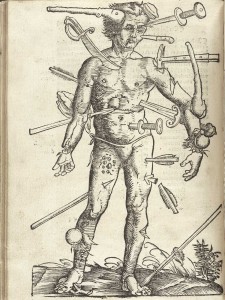Happy GURPS-Day, GURPSellians! I hope you enjoyed last week’s peek at my GM screen, but today we return to the “New to GURPS” series with “Intermediate Recovery,” a.k.a., “How do I fix these holes in me?”
Moving from GURPS Lite to the Basic Set maintains all the same core rules, just with more optional detail if desired.
This is one of the things that I love most about GURPS, by the way — there are entire rules subsystems available, as detailed as you want them to be (and optional, it cannot be stressed enough), for nearly any niche you want your character to fill.
A group’s campaign can go on happily for months, years, using only the parts of GURPS that support their characters. If none of those players find in-depth rules for social maneuvering or verbal battles of wits fun or interesting, the occasional Fast-Talk or Diplomacy roll is more than enough.
But, if someone then wants to make a new PC like a bard, or a “face,” or a con man, you just dust off those relevant sections of the Basic Set you’ve never bothered with before and keep on your merry way. And if that’s still not detailed enough, you grab Social Engineering and explore even more options.
The same with combat characters, of course (things like styles, grips, beats, etc. from Martial Arts), but also scientists, psis, magic users, gadgeteers, on and on. Each character introduced to the group brings with them the underlying rules that support the kinds of things they do. They get their own niche not just narratively, but with full support of the mechanics as well.
Okay, back to recuperation and healing up. Adventurers tend to get knocked around a fair bit (as well as shot, stabbed, burned, chewed…), so at some point, you need to know the rules for recovering from injury.
The basic look at this was confined mainly to “make a First-Aid roll and hope for the best.” The Basic Set throws in quite a lot of options for players who really want healing to be their “thing,” all covered on pp. 423-425. Beyond the First-Aid skill, healers (shamans, EMTs, combat medics, medical droids) can put points in:
 Diagnosis (p. 187), for figuring out what is wrong with a character not displaying any obvious trauma, such as internal injuries.
Diagnosis (p. 187), for figuring out what is wrong with a character not displaying any obvious trauma, such as internal injuries.All of these skills are affected by a number of modifiers (noted in their descriptions), things like quality or lack of equipment and the physiology of the patient (Is it a Saturnian, but you’re only familiar with Terrans?).
Optional rules on p. 420 allow for tracking bleeding from wounds (making it possible to die or pass out well after an injury if you don’t receive medical care), accumulated wounds (a more detailed method for tracking crippling injuries), and limiting limb/extremity damage to solid hits, not glancing blows.
There is also a wide array of afflictions (pp. 428-429) that can befall a character in the Basic Set — sneezing, being drunk, being in pain, etc. — each with their own effects and recoveries.
Finally, on the official forums, Kromm suggests a -1 penalty per HP lost when attempting First-Aid/Physician skill checks on yourself (assuming you can even realistically work on the area of the wound — if you’re shot in the back, there’s simply no way a normal human can reach that, regardless of how high his skill is.) This was originally intended for inclusion in the Basic Set.
Again, if there is no dedicated healer (PC or NPC) that tends to your group, most of these rules won’t add much to the flavor of the game — it’s just more info to track with little value added. If there is, though, you can have scenes like him trying to stop a comrade’s critically bleeding chest wound in the midst of a raging battle, with no idea of what the exact problem is because there was no time for a proper Diagnosis, and having to improvise closing it with a handkerchief, a glow-stick, and three shiny nickels.
Recovery doesn’t have to change much between GURPS Lite and the Basic Set — unless you want it to, in which case there’s no shortage of options for getting as detailed and super crunchy as you want!
(Psst… only one more entry left for the “intermediate” series of “New to GURPS” posts, “Intermediate Scene.” Then we get all advanced and stuff!)
If you enjoyed this post and others like it, might you consider the Game Geekery Patreon?
Prior to Tech Level 5 (the American Civil War/Industrial Age), surgery is often a poor idea. This is when higher HT and/or the various Resistant Advantages tend to be more important than easy access to medical care.
Oh, totally agreed, for more realistic settings. Best to avoid old-time surgery in those games.
Ouch.